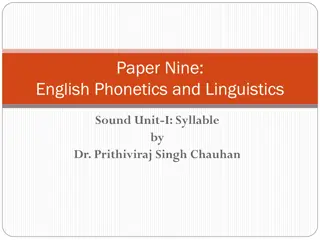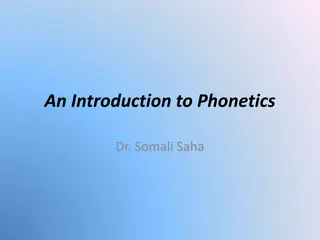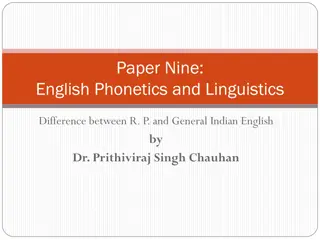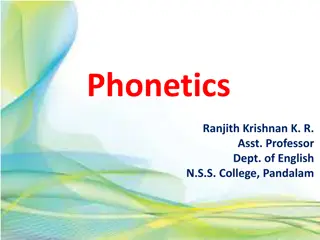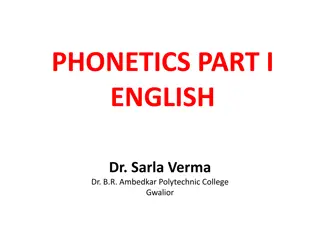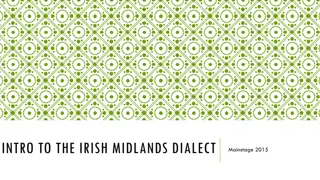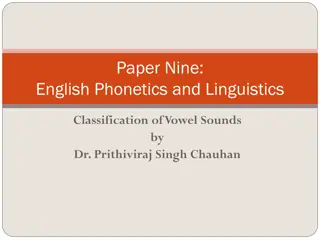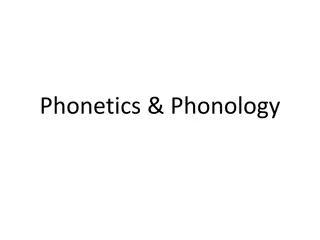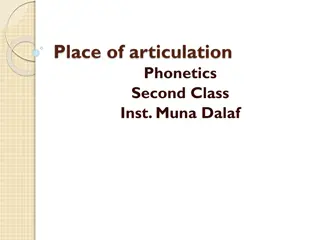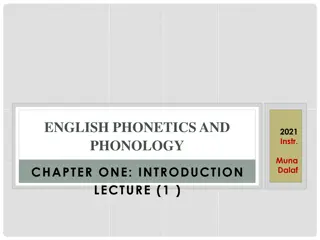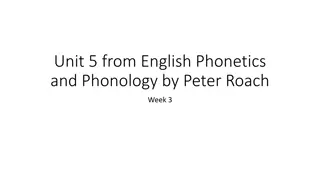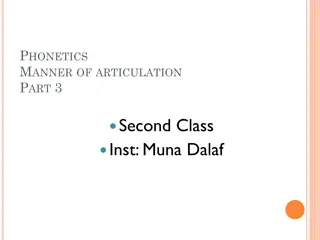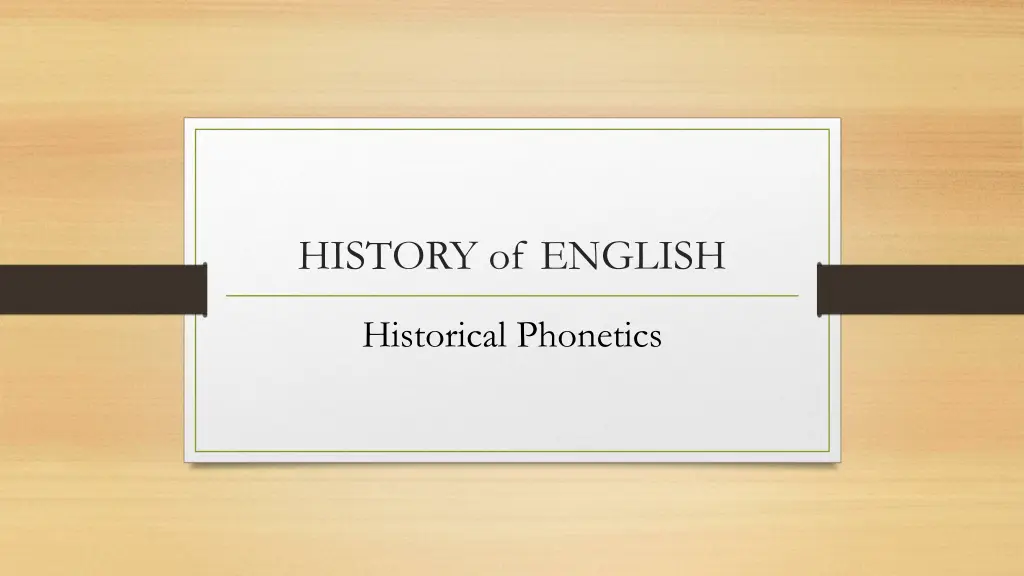
Evolution of English Phonetics
Explore the historical phonetic changes in the English language from Old English to Middle English, highlighting shifts in vowel and consonant phonemes, dialectal variations, and the impact of sociolinguistic events like the Norman Conquest. Discover how Middle English dialects diverged, leading to differences in spelling and pronunciation.
Download Presentation

Please find below an Image/Link to download the presentation.
The content on the website is provided AS IS for your information and personal use only. It may not be sold, licensed, or shared on other websites without obtaining consent from the author. If you encounter any issues during the download, it is possible that the publisher has removed the file from their server.
You are allowed to download the files provided on this website for personal or commercial use, subject to the condition that they are used lawfully. All files are the property of their respective owners.
The content on the website is provided AS IS for your information and personal use only. It may not be sold, licensed, or shared on other websites without obtaining consent from the author.
E N D
Presentation Transcript
HISTORY of ENGLISH Historical Phonetics
OUTLINE 1.Introduction 2. Sound Changes in the system of Middle English Vowel Phonemes 3.The Development of Old English diphthongs and the Rise of Middle English diphthongs 4. Sound Changes in the System of Vowel Phonemes in Modern English 5. Sound Changes in the System of Consonant Phonemes in the History of English 6. Conclusions
Introduction The most remarkable feature of the Middle English sound system is a growing tendency for dialectal variation. It was mainly accelerated by the changes in the sociolinguistic situation that arose after the Norman Conquest of 1066. The sound changes of Middle English increased the divergence among the Middle English dialects, though this divergence already existed in Old English. This also brought the diversity in spelling habits, when ME spelling began to differ from locality to locality.
The system of Old English vowel phonemes i(:) y(:) u(:) e(:) o(:) (:) a(:)
Middle English Vowel Development Short and long front and back vowels of high rise and middle rise remained unchanged. OE /i/ > ME /i/ OE /i:/ > ME /i:/ EOE fisc [fisk] > EME fissh, fyssh [fi ]; OE m n [mi:n] > ME mine [mi:n] OE /u/ > ME /u/ OE /u:/ > ME /u:/ OE wulf [wulf] > ME wolf, wulf [wulf]; OE m s [mu:s] > ME mous [mu:s] OE /e/ > ME /e/ OE west [west] > ME west [west] OE c pan [ke:pan] > ME kepen [ke:pen] OE /o/ > ME /o/ OE /o:/ > ME /o:/ OE folc [folk] > ME folc, folk(e) [folk]; OE m na [mo:na] > ME mone [mo:ne] OE /e:/> ME /e:/
Middle English Vowel Development The rounded short and long front vowels of high rise /y/ and /y:/ split into three dialectal variants and disappeared from the system of ME vowels. / (:)/ North and Midland /y (:)/ > /e (:)/ /u(:)/ West South Kent OE synne [syn:e] > ME sinne [sine] (North and Midland); senne [sene](Kent); sunne [sune] West South
Middle English Dialectal Divergence Some Modern English words show the mixture of dialectal forms when the pronunciation can be traced to one dialectal form while the written form comes back to the other. OE bysi [byzij] ME bisy [bizi] (North and East Midland) ME besy [bezi] (Kent) ME busy [buzi] (West South) Modern English busy [bizi]
Middle English Vowel Development The short back vowel of low rise /a/ remained unchanged except the Western dialects in which the nasalized variant turned into /o/ OE /a/ > ME /a/ and ME /o/ (in the West) OE l nd > ME land, ME lond (in the West) The long back vowel of low rise /a:/ developed into / :/ in all dialects in the 12thc. except the Northern dialects in which it remained unchanged. OE /a:/ > ME / :/ and /a:/ (in the North) OE st n [sta:n] > ME stone [st :n]; ME stane [sta:n] in the North Modern Scottish : stane walls Yorkshire : So I turned back to gan home
Middle English Vowel Development The short front open vowel of low rise / /developed into /a/ in all dialects except the Southern dialects in which it became /e/ OE / / > ME /a/ and /e/ (in the South) OE w s [w s] > ME was [was]; ME wes [wes] (in the South) OE b c [b k] > ME back [bak]; ME beck [bek] Modern English standard: back; the Kentish dialects and the Cockney dialect: beck.
Middle English Vowel Development The long front open vowel of low rise / :/ remained open in the majority of the dialects except Kent in which it became narrowed. This change was reflected in writing through introduction of the diagraphs <ea> and <ee>. OE / :/ > ME / :/ and ME /e:/ (mostly in Kent) OE d lan [d :lan] > ME dealen [d :len]; ME delen [de:len] (Kent) to deal OE sl pan [sl :pan] > ME slepen [sle:pen] (Kent, North Midland) to sleep In Northern dialects both vowels could be found.
The phonological essence of Middle English vowel development The most characteristic feature of the Middle English system of vowels is the replacement of the phonemes according to the dialect development A new vocalic correlation open/ closed appeared in the system which was represented by the vowels: e: / : and o: / :. The system of Middle English vowels lost symmetry in the number of short and long vowels EME i u i: u: e o e: o: a : :
Quantitative Sound Changes of Middle English Vowels EME vowels were short or long depending on the position they stood in. In the 12th-13thcenturies the short vowels /e/; /o/; /a/ were lengthened in open syllables of disyllabic words. The short vowels high rise /i/ and /u/ were affected only in the Northern dialects.The quantity of the vowel remained free only in monosyllabic words. OE /e/ > ME / :/ OE stelan [stelan] > ME stelen; stealen [st :len] OE /o/ > ME / :/ OE smocian [smokian] > ME smoken [sm :ken] OE /a/ > ME /a:/ OE nama [nama] > ME name [na:me] OE wicu [wiku] > ME weeke [we:ke] (in the North) OE duru [duru] > ME doore, dore [do:re] (in the North)
The phonological essence of quantitative changes 1. The ruin and loss of the phonological correlation of quantity in the system of Middle English monophthongs 2. By the end of the ME period, a new correlation checked / non- checked developed. Short vowels were interpreted as checked and long vowels as non-checked or free. 3. The strengthening of the position of long monophthongs The functional load of long vowels in the system of Middle English vocalism increased because the correlation open/close in long vowels became functionally more strengthened. 4. The appearance of the long back vowel phoneme of low rise /a:/
Middle English Vowel Development The system of Old English diphthongs was ruined when they became simplified and coincided with simple monophthongs in Early Middle English. OE ea [ a] > LOE / / > ME /a/ OE heard [h ard] > LOE (11thc.) h rd [h rd] > ME (12thc.) hard [ hard] OE a [ a:]> LOE / :/ > ME / :/ OE ast [ a:st]> ME east [ :st] OE o > ME /e:/ OE d op [deo:p] > ME deep,depe [de:p] OE eo > ME /e/ OE heorte [heorte] > ME herte [ herte]
Middle English Vowel Development In Early Middle English new diphthongs arose as a result of the vocalization of some fricatives. The first stage of the vocalization (EME) involves the OE voiced palatal [j] and velar [ ] fricatives and the semi-vowel /w/. The second stage of the vocalization (LME) involves the OE voiceless palatal [x ] and velar [x] fricatives. This vocalization greatly supported the general process of the rise of a new correlation checked/non-checked.
EME vocalization of fricatives The vowels which resulted from the Early Middle English vocalization of the voiced velar and palatal fricatives and the semi-vowel /w/ phonetically formed a diphthong with a preceding vowel of the middle or of the low rise. OE d [d j] > EME d i [d i], dei [dei], dai,day [dai] day OE we [wej] > EME wei [wei] way OE la u [la u] >EME lawe [lau ] law OE sn w [sn w] > EME snow [snou] snow
Middle English Diphthongs The vocalization of the palatal fricative [j] after the front vowel of the high rise /i/ resulted in the development of a new diphthong /i /. OE ti ol [tijol] >EME ti ele,tegel, tile [ tijl > ti l >ti:l] The vocalization of the velar [ ] after the back vowel of high rise /u/ resulted in the development of a new diphthong /u /. OE fu ol [fu ol] > EME fowel [fu l], foule [fu l ]
The LME vocalization of fricatives (the14 cent.) The vocalization of the voiceless dorsal and velar fricatives [x ] and [x] phonetically went through the appearance of the gliding sound /i/ or /u/ between the fricative and the preceding sound. This sound was reflected in spelling. OE br hte [bro:xte] > EME bro te [ broxte] > LME broughte [brouxt ] brought OE t hte [t :xte] > EME ta te [taxte] > LME taughte [tauxt ] taught OE niht [nix t] > ME night [ ni x t] night OE eahta [eax t ] > EME ehte [ex te] >LME eighte [eix t ] eight
Middle English Diphthongs The Middle English diphthong /eu/iu/ was the result of the contraction of Old English diphthongs and the vocalization of the semi-vowel /w/. OE f awe [f awe] > ME fewe [ feu ] few In the 13th 14thcenturies the diphthong /oi/ appeared in the phonetic structure of such words as: joy, point, boy, joint, choice etc., as the result of the process of French borrowing.
General Features of the ME Diphthongs 1. Structurally, ME diphthongs fall into two subdivisions: a) with the second element of the /i/-character; b) with the second element of the /u/-character. Their first element ( the nucleus) was more open and their second element (the glide) was closer, as compared with OE diphthongs. 2. Genetically, they were mostly the result of the vocalization of some consonants. 3. No more did long and short diphthongs exist which shows the disappearance of the correlation of short/long.
The system of LME Diphthongs i u i / e e o o a a
The phonological essence The phonological essence of the formation of a new system of Middle English diphthongs lies in the replacement of the vocalic correlation short/long by the correlation checked/non-checked. As a result of the vocalization the diphthongs were really interpreted as monophonemic structures or free (non-checked) vowels i /i: u / u:
Conclusions As a result of all qualitative and quantitative sound changes, the Middle English system of vowels became a system greatly characterized by a dialectal development. The Old English diphthongs were simplified and the system of Old English diphthongs was ruined. The position of the contrast long : short in the vocalic system weakened as a result of qualitative and quantitative changes and the loss of the system of OE diphthongs. As a result of these changes, monophthongs lost one of the important phonological correlations, the correlation of quantity. Middle English diphthongs arose as a result of vocalization of fricatives.

